February 2017 LIP of the Month
Basalts and picrites from a plume-type ophiolite in the South Qilian Accretionary Belt, Qilian Orogen: Accretion of a Cambrian Oceanic Plateau?
Yuqi Zhanga, Shuguang Songa*, Liming Yanga, Li Sub, Yaoling Niuc,d, Mark B. Allenc, Xin Xua
a MOE key Laboratory of Orogenic Belt and Crustal Evolution, School of Earth and Space Sciences, Peking University, Beijing 100871, China
b Institute of Earth Science and State Key Laboratory of Geological Processes and Mineral Resources, Chinese University of Geosciences, Beijing 100083, China
c Department of Earth Sciences, Durham University, Durham DH1 3LE, UK
dInstitute of Oceanology, Chinese Academy of Science, Qingdao 266071, China
E-mail address: sgsong@pku.edu.cn (Shuguang Song)
Extracted and modified after: Zhang, Y.Q., Song, S.G., Yang, L.M., Su, L., Niu, Y.L., Allen, M.B., Xu, X., 2017. Basalts and picrites from a plume-type ophiolite in the South Qilian Accretionary Belt, Qilian Orogen: Accretion of a Cambrian Oceanic Plateau? Lithos 278–281, 97-110. DOI: 10.1016/j.lithos.2017.01.027 http://dx.doi.org/10.1016/j.lithos.2017.01.027
1. Introduction
Most volcanism in ocean basins occurs at plate boundaries: mid-ocean ridges and subduction zones. In contrast, the rocks of oceanic plateaus, oceanic islands and seamounts are different from the plate margin magmatism in composition (e.g., Kerr et al., 1996a, b). Although these intraplate igneous rocks only represent <1% of all igneous rocks on Earth, great emphasis has been placed on them because they provide insights into mantle composition, magma formation processes and magma evolution (Greenough et al., 2005). Oceanic plateaus represent an enormous transfer of magma from the mantle to crust, mostly as submarine large igneous provinces (LIPs) (>100,000km2) (Coffin and Eldholm, 1994; Condie, 2001; Ernst, 2014). Most of the oceanic plateaus formed in a span of a few million years, suggesting immense volcanic eruptions with global impact related to continental break-up (Coffin and Eldholm, 1992; Kerr and Mahoney, 2007). The origin of oceanic islands has been debated throughout the development of plate tectonic theory, but the most popular opinion is still “hot spot” or mantle plume, which is consistent with the geochemical features of oceanic island volcanic rocks (Hofmann and White, 1982; Morgan, 1971).
Since the term “komatiite” was first introduced to describe the MgO-rich lavas in the Barberton area, South Africa (Viljoen and Viljoen, 1969), it has attracted considerable interest in the geochemical community (Arndt et al., 2008). Its high-Mg counterparts with or without spinifex texture in post-Archean times indicate a hotter than normal mantle origin (mantle potential temperature, Tp ~1450-1600°C), and thus a higher degree of melting is needed for their formation (e.g., Kerr et al., 1996a,b; Arndt et al., 1997, 2008; Shimizu et al., 2001). Their origin has a close affinity with the activity of mantle plumes (Herzberg and Hara, 2002; Herzberg et al., 2007; Herzberg and Asimow, 2015). As a requisite product of mantle plume activities, high-Mg magmas such as spinifex-textured or non-spinifex komatiitic rocks (e.g., Le Bas, 2000; Kerr and Arndt, 2001), are rare in occurrences in the Earth’s history and generally are associated with LIPs caused by large hot plumes from the deep mantle (e.g., Campbell and Griffiths, 1990; Richards et al., 1989; Kerr et al., 1996b).
In this paper, we present detailed petrological and geochemical data of the volcanic rocks from the Lajishan and Yongjing ophiolites (LYO) of the South Qilian Accretionary Belt (SQAB), Qilian Orogen. We have determined that the LYO sequences are products of a fragmented ocean plateau generated in the Cambrian (~525 Ma), and provide the first evidence for the activity of a mantle plume preserved in northwestern China at this time. In addition, we propose an accretionary mechanism by “trench jam” of plateau rocks in the subduction zone.
2. Regional geology
The Qilian orogenic belt, presently exposed at the northern margin of the Qinghai-Tibetan Plateau, northwestern China is part of the Qinling-Qilian-Kunlun Fold System (e.g., Jiang, 2000). It is situated at a triple junction between the North China Craton (NCC), the Yangtze Craton (YC) and the Tarim Craton (TC) in the northwest (Fig. 1).
The whole Qilian-Qaidam region consists of two oceanic accretionary belts and one continental-type ultra-high pressure metamorphic (UHPM) belt, juxtaposed with two Precambrian blocks, from north to south, (1) the North Qilian Accretionary Belt, (2) the Central Qilian Block, (3) the South Qilian Accretionary Belt, (4) the Quanji Block and (5) the North Qaidam UHPM Belt (Fig. 1).
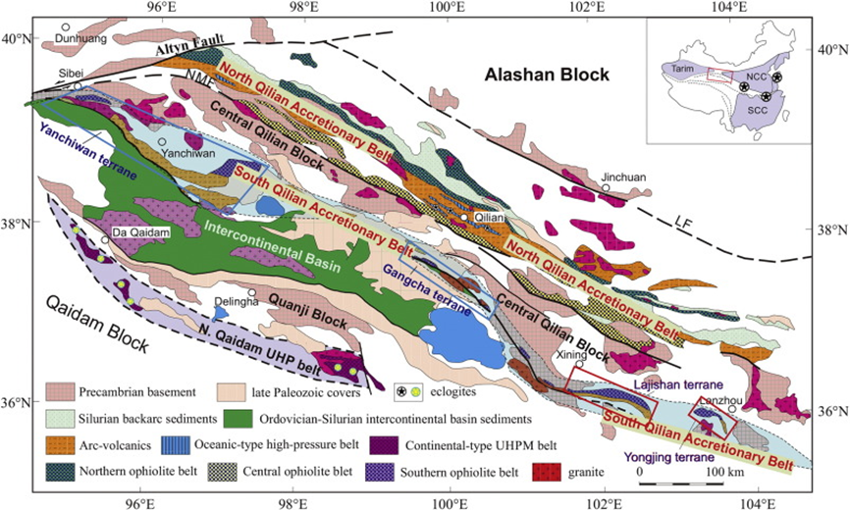
Fig. 1. Simplified geological map of the Qilian-Qaidam orogens showing two accretionary belts (North Qilian and South Qilian accretionary belts) and the localities (red rectangles) of the Lajishan and Yongjing ophiolites of this study.
The North Qilian Accretionary Belt records globally one of the earliest “cold” oceanic subduction zones, in response to the closure of the ancient Qilian Ocean between the Alashan and Qilian-Qaidam blocks during the Early Paleozoic (Wu et al., 1993; Song et al., 2006, 2007, 2009, 2013; Zhang et al., 2007; Yin et al., 2007; Xiao et al., 2009). It consists of Precambrian basement, Early Paleozoic subduction-related rock associations (ophiolite complexes, high-pressure/ low-temperature metamorphic rocks, arc-related volcanic and intrusive rocks), Silurian flysch and Devonian molasses formations, and later sedimentary cover (Song et al., 2013). The Qilian Block is a thrust belt of slices of Precambrian basement, overlain by Paleozoic sedimentary sequences. The basement consists of granitic gneiss, marble, amphibolite and minor granulite with ages of 880-940Ma (Tung et al., 2007; Wan et al., 2001), similar to ages of the granitic gneisses in the North Qaidam UHPM Belt (Song et al., 2012).
The South Qilian Accretionary Belt (SQAB) occurs as discontinuous fault-bound slivers along a NW-SE orientation between the Central Qilian and Quanji blocks, in parallel to the North Qilian Accretionary Belt (Fig. 1). From NW to SE, this belt consists of the Yanchiwan Terrane, the Gangcha Terrane, the Lajishan Terrane and the Yongjing Terrane, in total around 1000 km in length (Fig. 1). The accretionary belt is composed of two sequences: the ophiolite sequence and the arc-volcanic sequence; no high-pressure metamorphic rocks have been found in these areas. The arc-volcanic sequence consists of mafic to intermediate volcanic rocks of Ordovician age (460-440 Ma), in which forearc boninite has also been reported (Yang et al., 2002; Song et al., unpublished data), Compositions suggest that they formed in an intra-oceanic arc environment; boninites have also been reported in this belt, interpreted as having a forearc origin (Yang et al., 2002). Most of the ophiolite rocks crop out in the north relative to the arc sequence (Fig. 1), and they consist of ultramafic rocks (pyroxenite and dunite), gabbros, massive and pillow basalts and pelagic chert.
3. Rock assemblages and petrography
The Lajishan Ophiolite occurs as a narrow terrane occupying an area of ~150×75 km2, between the two thrust faults of the NW-SE orientation. To its south are the Ordovician arc-volcanic sequences. The ophiolite is composed of voluminous mafic volcanic rocks (pillow and massive lavas/dykes) associated with minor pelagic sedimentary rocks such as the red radiolarian chert (Figs. 2a and 2b). Mafic to ultramafic rocks from the basal part of the ophiolite suite are sporadically scattered within the terrane, including serpentinised mantle harzburgite, cumulate peridotite and pyroxenite. Basaltic rocks occur mainly as pillow basalts that have been interpreted as thin submarine flows.
The Yongjing Ophiolite mainly consists of massive and pillow basalts and two small serpentinised ultramafic bodies. The massive basalts have a green colour and occur as thick layered lavas without columnar jointing, which probably represent the thick lava flows of fast eruption (Aitken and Echeverría, 1984). Some outcrops look like sheeted dykes with nested chilled margins (Fig. 2c). The pillow basalts have a dark-green colour, and overlap onto the massive basalts (Fig. 2d); some pillows are slightly deformed (Fig. 2e).
Picrites in the Yongjing Ophiolite are dark-coloured lavas with pillowed structure (Figs. 2f and 2g). They have experienced ocean floor alteration with the development of the typical mineral assemblage of low-grade greenschist facies conditions. All olivines have been altered to chlorite or serpentinite, and pyroxene has altered to tremolite. Subalkaline basalts possess conspicuous ophitic textures with plagioclase serving as the frame and clinopyroxene filling into the gaps in between. Flow structure occurs in some alkaline basalts. Some rocks with high-Cr composition also contain chrome spinels.
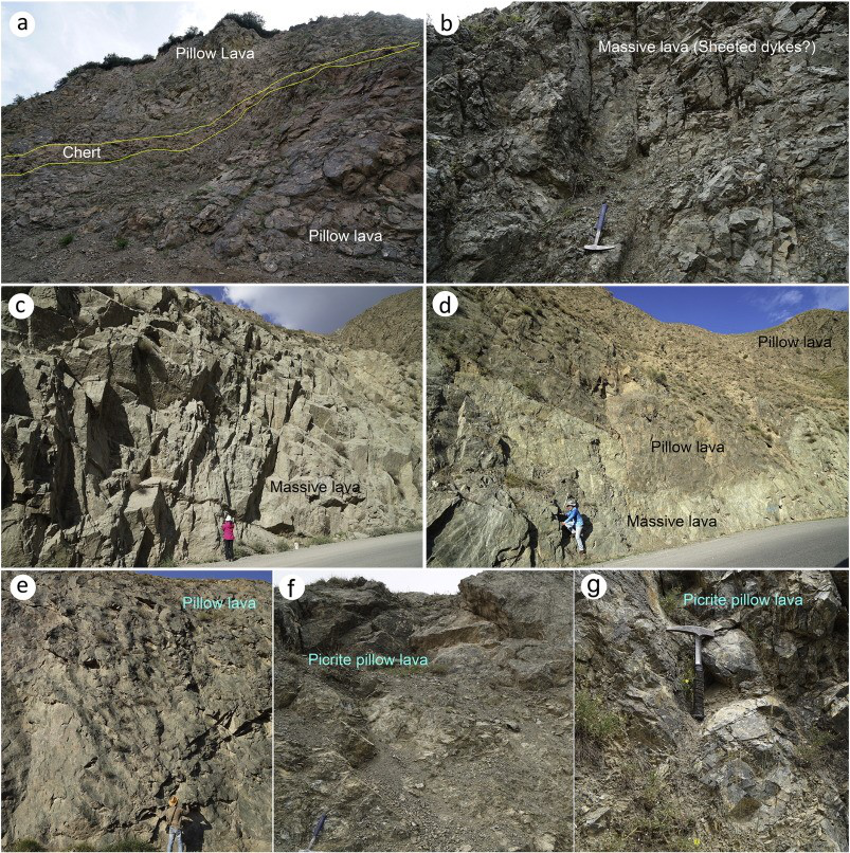
Fig. 2. Field photos of the Lajishan-Yongjing ophiolite terranes. (a) Pillow basalts with red chert in the Lajishan locality. (b) Massive lavas (sheeted dykes?) in the Lajishan locality. (c) Voluminous massive lava in the Yongjing locality. (d) and (e) Pillow lava overlaying the massive lavas in the Yongjing locality. (f) and (g) high-Mg komatiitic basalts with pillow structure.
4. Whole-rock geochemistry and zircon U-Pb studies
4.1 Geochemical feature of Lajishan basalts
4.2.1 Whole-rock major and trace element analysis
The analysed samples are predominantly basaltic and present large ranges of MgO and total alkali (Na2O + K2O) contents. In the (Nb/Y)-(Zr/TiO2) diagram (Winchester and Floyd, 1976), some samples plot in the alkaline field, while others are in the subalkaline field. Six pillow basalt samples and one massive basalt sample (13QLS-137) from the Yongjing Ophiolite have very high MgO contents (> 18 wt.%). All the high-Mg pillow basalts plot in the alkaline field of the (Nb/Y)-(Zr/TiO2) diagram with high Ti/Y ratios more than 500, except for the massive basaltic sample 13QLS-137. According to these geochemical features, we can subdivide these basaltic samples into three groups: (1) the sub-alkaline group, (2) the alkaline group and (3) the high-Mg group.
(1) Sub-alkaline basalts. This group of basalts are characterised by relatively low TiO2, Nb, Ni, Zr, but high Yb and V relative to alkaline basalts; they have sub-alkaline, tholeiitic compositions; major element characteristics are more variable. They also have low Nb/Y and Ti/Y (mostly <500), very different from the alkaline basalts. They possess slight enrichment of LREE and MREE, with (La/Yb)N ranging from 1.24 to 4.45 and (Sm/Yb)N from 1.19 to 2.58. The REE and trace element patterns illustrate that these rocks are similar to typical present-day enriched E-MORB (Fig. 3a, b).
(2) Alkaline basalts. The alkaline basalts display MREE/HREE and LREE/HREE enriched patterns. They have higher Nb/Y (0.76-2.32) and Ti/Y (mostly >500) than the sub-alkaline basalts. The overall geochemical features of these basalts resemble those of alkaline basalts generated at within-plate oceanic island settings (Fig. 3 c,d), as also exemplified by the relatively high Ti/V (~50), their Th/Yb-Ta/Yb ratios as well as other most common tectonic discrimination diagrams, compared with the sub-alkaline basalts.
(3) Picrites. One sample (13QLS-137) occurs as massive basalt below the pillow lavas layer, and others crop out as pillow basalts in the field. These rocks are characterised by high MgO (>18 wt%) with 48-52 wt% SiO2. Most of samples have higher TiO2 than 1% except for massive basalt 13QLS-137. The major element composition closely analogous to komatiites (TiO2 < 1%) and memeichite (TiO2>1%) classified by Le Bas (2000). In the Nb/Y-Zr/Ti diagram, the high-Mg pillowed basalts plot in the alkaline field, while the high-Mg massive basalt plots in the sub-alkaline field. They are also classified as alkaline series with significant negative Sr and Rb, Ba and Sr anomalies. They show similar REE and multi-element spider patterns to the E-MORB, except for the strong Rb, Ba and Sr depletion.
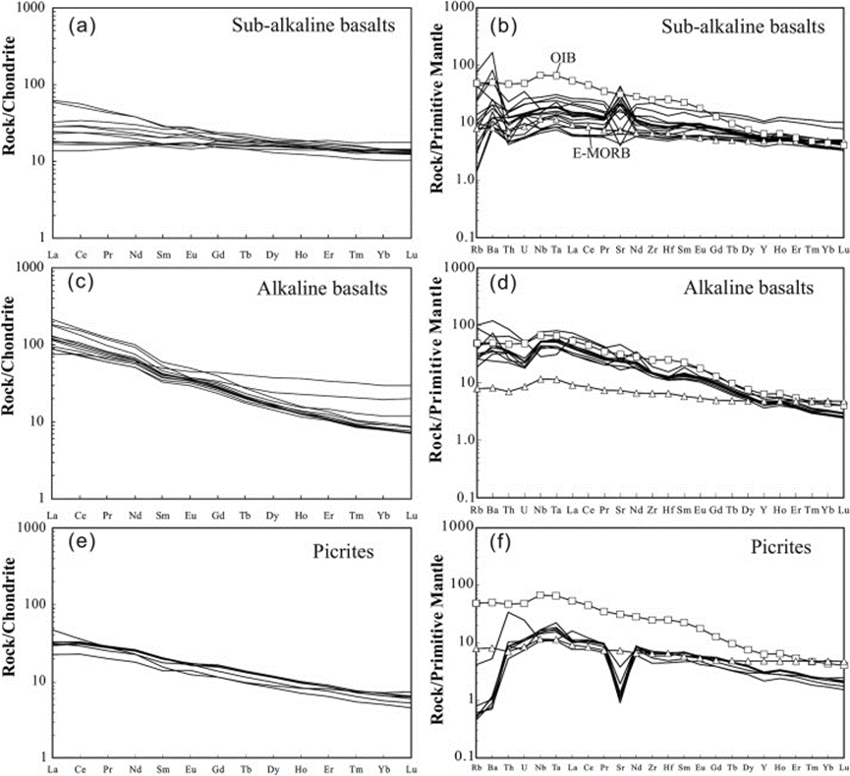
Fig. 3. Chondrite-normalised REE patterns (a, c, e) and primitive mantle normalised trace element patterns (b,d,f) for three groups of samples respectively. Also shown are compositions of OIB in (d) and (f) and enriched MORB (E-type MORB) in (b) for comparison. The normalisation values and the OIB and E-type MORB values are from Sun and McDonough (1989).
4.2.2 Spinel
Chromian spinel (Mg, Fe2+)(Cr, Al, Fe3+)2O4 is a ubiquitous accessory phase in basalts and peridotites, which is effective for distinguishing tectonic settings and the degree of mantle partial melting (Dick and Bullen, 1984). Chromian-rich spinels have been observed in three rock-types in the study area, including cumulate pyroxenite, alkaline basalts and picrites in the LYO. As shown in Figure 4a, chromian spinels from the cumulate pyroxenite show a wide range of TiO2 between 0.11-1.08 wt% (mostly > 0.5 wt%), and a narrow range of Al2O3. Their Cr# (Cr/(Cr+Al)) values are 0.55-0.70, higher than that of the N-type MORB and abyssal peridotite (Fig.4b, mostly < 0.6) (e.g., Dick and Bullen, 1984). Spinels from the alkaline basalts have high TiO2 and Al2O3, but low Cr#. Spinels from the picrites have high content of TiO2 (1.60-2.88 wt.%) but relatively low Al2O3, and mostly plot in the field of OIB (Fig. 4a). They also have high Cr# (Cr# = Cr/(Cr+Al)), ranging from 0.52 to 0.64, higher than spinels from the Ontong Java Plateau (0.46-0.52, Sano et al., 2015).
The spinel composition, as indicated by numerous studies, is a complex function of magma and source peridotite compositions (Kamenetsky et al., 2001). Magmatic abundances of trivalent (Al, Cr) and tetravalent (Ti) cations, unlike Mg2+ and Fe2+ in spinel, experience very little change during post-entrapment re-equilibration because of their low diffusivity, so they can be used to infer magmatic source (Barnes, 1998; Kamenetsky et al., 2001; Roeder and Campbell, 1985). A positive correlation between Al2O3 and TiO2 in spinel and coexisting melt is demonstrated over significant intervals of averaged spinel and melt compositions sampled from a variety of magmatic types and tectonic environments (Crawford, 1980; Dick and Bullen, 1984; Kamenetsky, 1996). The dependence of spinel Al2O3 and TiO2 concentrations on the parental melt composition suggests the use of an Al2O3 vs. TiO2 diagram to discriminate spinel that crystallised from different magmas in different tectonic environments (Kamenetsky et al., 2001). The relationships between Al2O3 and TiO2 (Fig. 4a) of the alkaline and picrites show the relatively high TiO2. As shown in Fig. 4b, high-Mg komatiitic basalts and pyroxenite possess higher Cr# than normal MORB and abyssal peridotite. The compositions of different spinels are also plotted in the Cr-Al-Fe3+ ternary diagram (Fig. 4c), where picrites plot in the oceanic LIP (OLIP) field while alkaline basalts possess relatively lower Cr compositions.
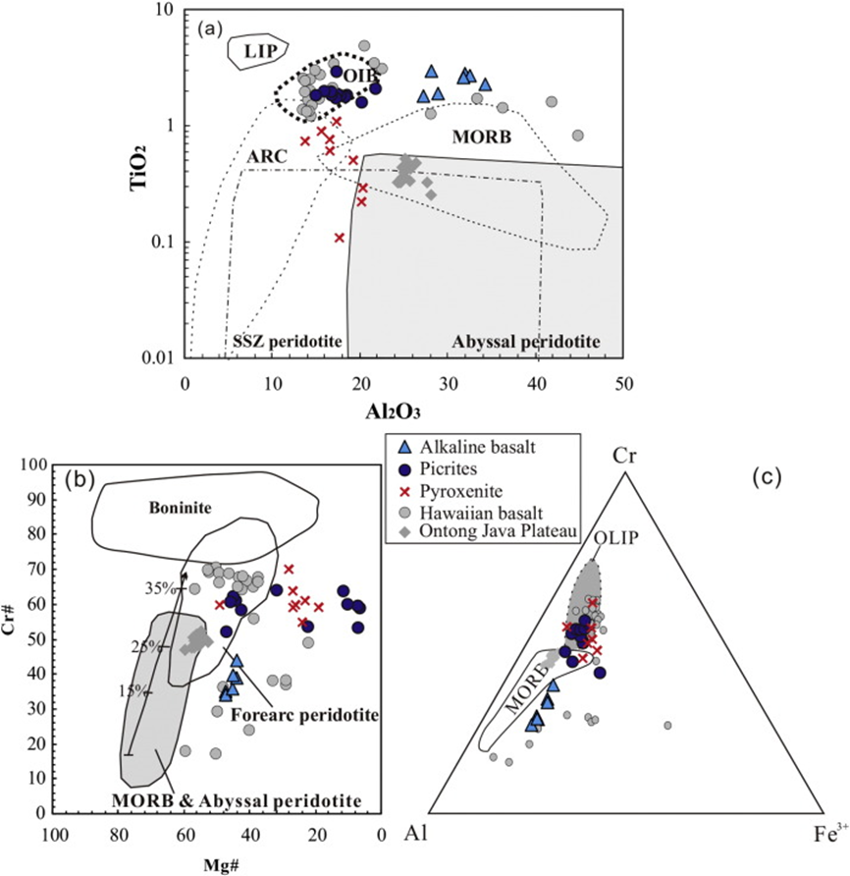
Fig. 4. Spinel compositions of the Lajishan-Yongjing ophiolites. (a) Al2O3 vs TiO2 diagram for spinels from alkaline, picrites and pyroxenites (Kamenetsky et al., 2001) (b) Cr# [Cr/(Cr + Al)] vs Mg# [Mg/(Mg + Fe2 +)]diagram for spinels (Dick and Bullen, 1984). (c) Cr-Al-Fe3 + ternary plot for chromian spinel. Discrimination fields of oceanic large igneous province (OLIP) are from Tokuyama and Batiza (1981); MORB are from Gaetani et al. (1995). Spinel data of the Ontong Java Plateau and Hawaiian basalts are from Sano (2015) and Norman and Garcia (1999), respectively.
4.2.3 Whole-rock Sr-Nd isotopic data
Oceanic island basalts have gained a lot of attention because their isotopic compositions are different from MORB, reflecting different mantle source regions (Hofmann and Hart, 1978). Six sub-alkaline, three alkaline basalts and two high-Mg komatiitic basalts were analyzed for whole-rock Sr-Nd isotopic composition. The results are illustrated in Figure 5. The initial values of the Sr-Nd isotope were calculated at 525 Ma. The sub-alkaline and alkaline basalts have variable 87Sr/86Sr ratios. The sub-alkaline basalts possess relatively higher 143Nd/144Nd values than alkaline basalts. Most of the basalts have positive εNd(T) values (0.9-8.9) except for sample 12LJ-29 which have negative εNd(T) of -0.1. The positive εNd(T) values are similar to those of modern plume-related OIB (Zindler, 1986; White and Duncan, 1996). The relatively high initial Sr isotopic values in some samples may be attributed to the alteration by sea water and hydrothermal fluids.
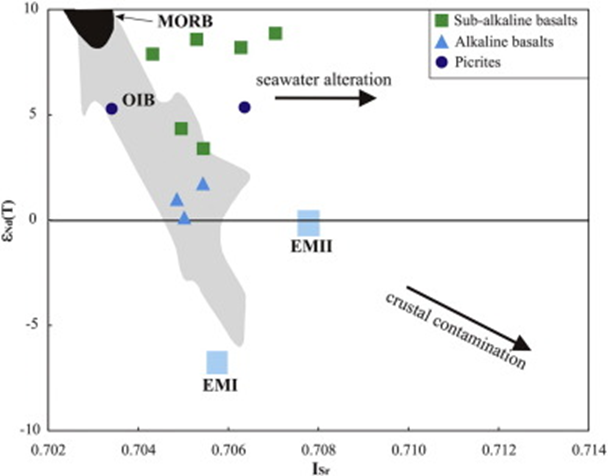
Fig. 5. Sr-Nd isotopic compositions for the Lajishan basalts. Plotted for comparison are: the modern depleted upper mantle (N-MORB) (Zimmer et al., 1995), OIB (White and Duncan, 1996 and Zindler, 1986), and EMI and EMII member (Hart, 1988).
4.3 U-Pb zircon age
One gabbro sample that occurs as a sill within the pillow lavas was selected for LA-ICP-MS zircon U-Pb dating. About 45 zircon grains were recovered and they are colourless, euhedral to irregular crystals with varying long axis (50-250μm and length/width ratios of 1.2-2.5). CL images show dark to intermediate luminescence with straight and wide oscillatory growth bands.
Zircons from the sample have relatively high Th/U (0.34-1.56). Nineteen spots were analysed on nineteen zircon grains, yielding apparent 206Pb/238U ages of 507-531 Ma, and forming a concordia age of 525±3 Ma (mean square weighted deviation, MSWD = 0.52). This age would, at least, represent the minimum formation age of the ophiolite, within the time span of the Qilian Ocean (ca. 550-500 Ma, Song et al., 2013).
5. Discussion
5.1 Petrogenesis and forming conditions
5.1.1 Mantle conditions
Mantle source temperature represents the temperature of mantle material if it adiabatically ascended to the Earth’s surface without melting (McKenzie and Bickle, 1988). Highly magnesian volcanic rocks are widely used to estimate mantle melting conditions and mantle compositions because their compositions are thought to be close to the primary mantle-derived melts (Larsen and Pedersen, 2000).
We use the PRIMELT3 software to calculate Tp for mantle, in order to distinguish relatively hotter from colder mantle sources, which is important in understanding the thermal characteristics of ambient and anomalous mantle (Herzberg and Asimow, 2015). We choose the picrites which have the closest affinity with primary magma, and regard the geochemistry of these picrites as representative of primary magma compositions. Using parameterised experimental data on mantle melting phase relations, we estimated that the Tp is 1489-1600°C (the potential temperature of the mantle source is obtained in terms of the equation of:
Tp(°C) = 1025 + 28.6MgO - 0.084*MgO2,
Herzberg et al., 2007). The Tp is obviously higher than the 1350°C of the upper mantle (Davies, 2009; Korenaga, 2008), and close to the 1500-1600°C of Hawaiian picrites (Herzberg et al., 2007; Lee et al., 2009), which demonstrates an anomalously hot mantle source for the Cambrian volcanics.
5.1.2 Degree of partial melting
Cr is a compatible element, preferring to stay in residue; only when the degree of melting is high enough does it go into the melt. So the higher the Cr contents are in the melt, the higher degree of melting there is. It is generally thought that spinels in basalts are in equilibrium with melt, and the chromium number (Cr#) in spinel as an indicator of partial melting correlates well with trace elements (e.g. Dy, Er, Yb) in clinopyroxene. Hellebrand et al. (2001) gave an equation: F = 10ln(Cr#) + 24 for spinels to estimate the relationship between Cr# and F, where F is the degree of melting.
The calculated F of alkaline basalts ranges from 12.9% to 15.6%; while the F of high-Mg komatiitic basalts ranges from 17.5% to 19.6% and pyroxenites ranges from 18.0% to 20.4%. The calculated F of the picrites using the PRIMELTS 3.0 ranges from 38-44%. All the results are higher than of most N-type MORB (~15% by Niu, 1997 or ~6% by Workman and Hart, 2005).
5.2 Determination of a Cambrian (~525 Ma) oceanic plateau
The basalts in the LYO complexes possess massive and pillow structures associated with abyssal deposits (e.g. red chert), indicating that the eruption was in an underwater environment. All the three rock groups, including sub-alkaline, alkaline and high-Mg komatiitic basalts, exhibit E-MORB and OIB-type geochemical features, which are different from the N-type MORB in most present day ocean ridges. Such a signature is thought to be diagnostic of hot spot or plume related basalts associated with oceanic islands (Hofmann, 1997).
In the Th/Yb vs. Ta/Yb diagram (Fig. 6a), the sub-alkaline basalts are close to the E-MORB composition, the alkaline basalts close to OIB composition; and the picrites plot between OIB and E-MORB compositions (Sun and McDonough, 1989). In the Nb/Y and Zr/Y variation diagrams (Fig. 6b), all samples plot within the field of Icelandic data (Fitton et al, 1997).
Ratios of highly incompatible trace elements in basalts reflect the geochemical composition of their mantle sources and therefore provide information about the distribution of the HFSE in the mantle. As shown in Fig. 6c, Nb/Ta ratios in OIB are decoupled from Zr/Hf ratios (Pfänder et al., 2007). Moreover, most of the samples are plotted in the same field as OIBs from the world’s main oceanic islands like Rurutu (Chauvel et al., 1997), Tubuai (Chauvel et al., 1992), Azores (Bieier et al., 2006), Pitcairn (Eisele et al., 2002) and Samoa (Workman et al., 2004), which are shown in the field of OIB in Fig. 6c. In the Nb/La vs Nb/Th diagram (Fig. 6d), picrites are quite similar to the Kostomuksha komatiites except for higher Nb contents, and most of the picrites lie close to the field of recent oceanic plateaus.
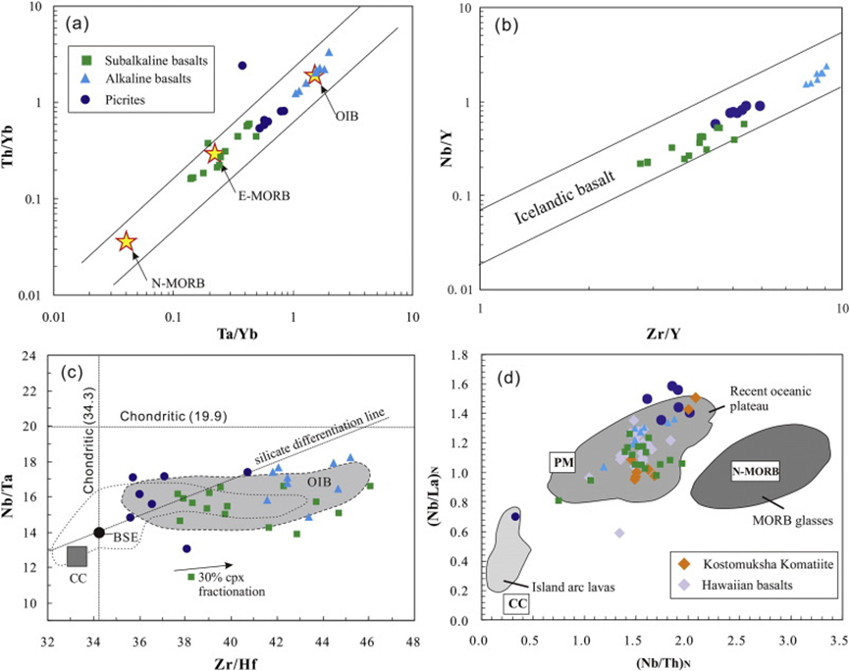
Fig. 6. Tectonic discrimination diagrams for various rock series the Lajishan-Yongjing ophiolitic complexes (a) Ta/Yb vs. Th/Yb diagram for basalts from the Lajishan ophiolitic complex (modified after Pearce, 1982). The compositions of modern normal mid-ocean ridge basalt (N-MORB), enriched mid-ocean ridge basalt (E-MORB), and ocean-island basalt (OIB) are from Sun and McDonough (1989); (b) Nb/Y-Zr/Y diagram from Fitton et al. (1997); (c) Nb/Ta versus Zr/Hf in ocean island basalts. Also shown is the field for MORB, average composition of the continental crust (CC, Zr/Hf and Nb/Ta from Barth et al., 2000) and OIB from Pfänder et al. (2007), Bieier et al. (2006), Chauvel et al. (1992), Chauvel et al. (1997), Eisele et al. (2002), Münker et al. (2003). Chondritic Nb/Ta and Zr/Hf from Münker et al. (2003). The arrow indicates the shift in Zr/Hf and Nb/Ta that results from 30% clinopyroxene fractionation (calculated from Pfänder et al., 2007). (d) Primitive mantle-normalised (Nb/Th)N vs. (Nb/La)N data for LYO picrites and basalts. Normalisation values are from Sun and McDonough (1989). Data from Kostomuksha komatiite (Puchtel et al., 1998) and Hawaiian basalts (Norman and Garcia, 1999) are added for comparison. The field of recent oceanic plateau, MORB and island arc tholeiites are from Puchtel et al. (1998).
The REE compositions of basalts from the LYO show marked LREE/MREE enrichment (LaN/SmN=1.04-3.17) coupled with prominent MREE/HREE enrichment (SmN/YbN=1.19-5.19). Besides, all the samples possess low contents of HREE with right inclined patterns, suggesting that these basalts were derived from the source region with the presence of garnet as a residual phase that preferentially holds heavy REEs (Irving and Frey, 1978). Using the Fractionate-PT model of Lee (2009), the calculated depths of melting range from 2.0-3.4 GPa, in accordance with depths where garnet is a residual phase.
In summary, on the basis of petrology, geochemical and isotopic data described above, we conclude that the basalts form LYO complexes formed in an intra-oceanic setting, most likely an oceanic plateau associated with a mantle plume; no other explanation seems viable for the presence of the high-Mg komatiitic basalts.
5.3 Tectonic implications: trench jam and new intra-oceanic arc generation
When a subducting ocean plate contains a body that is too buoyant to subduct the phenomenon of “trench jam” can occur (e.g., Abbott et al., 1997; Niu et al., 2003, 2015), with the consequence that a new subduction zone and volcanic arc are generated. Oceanic plateaus are the best candidates for such a buoyant and unsubductable mass, given the relatively low densities of the high percentage melts present in such crust (Herzberg, 1999; Niu and Batiza, 1991; Niu et al., 2003; O'Hara, 1973).
As described above, the high-Mg and OIB-type basalts in the LYO are interpreted to be the products of melting of a mantle plume, and they did not experience subduction, but were obducted as an ophiolitic component in the South Qilian Accretionary Belt. The age data (525±3 Ma) reveals that at least a component of the oceanic crust formed in the Late Cambrian. More importantly, the South Qilian Accretionary Belt has also incorporated intra-oceanic arc volcanic rocks (Fig. 1), which formed in a narrow time span from ~ 470 to 440 Ma (Yang et al., 2002), much younger in age and shorter in duration than the arc volcanism in the North Qilian Accretionary Belt (Song et al., 2013). We suggest that the newly formed arc volcanic sequence would be closely associated with the collision between the plateau and the pre-existing trench at ~470 Ma, on the basis of the age of the oldest arc volcanics in the South Qilian Accretionary Belt. This scenario is illustrated in Fig. 7.
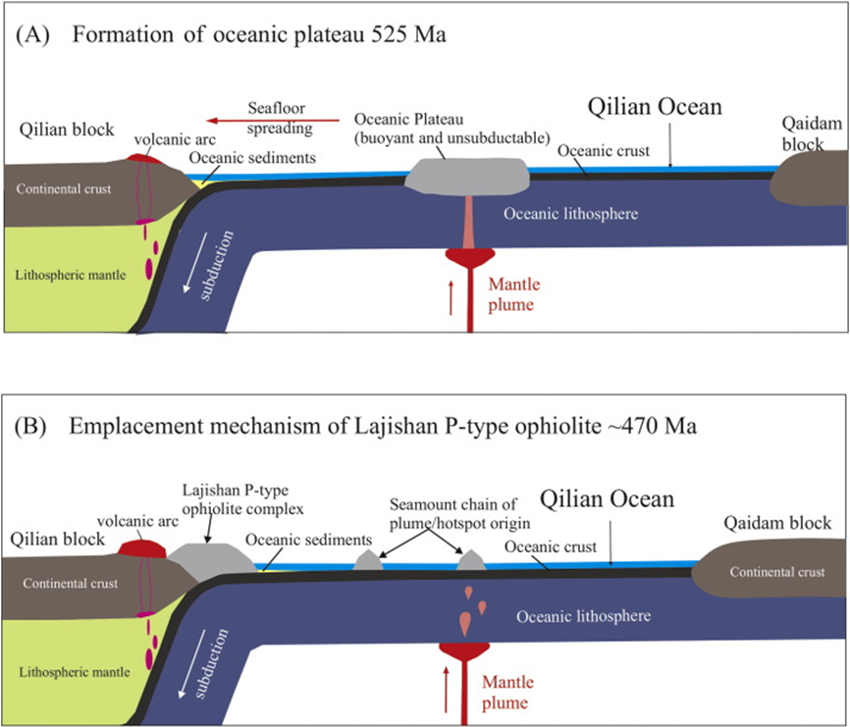
Fig. 7. Cartoons showing the tectono-magmatic evolution for the Lajishan-Yongjing P-type ophiolite complex for the Early Cambrian: (A) plume origin for an oceanic plateau at 525 Ma; (B) The buoyant plateau reached the subduction zone and became a part of newly accreted continent at about 500 Ma. Modified after Niu et al. (2015).
6. Conclusions
- Geochemical, isotopic and geochronological data suggest that the LYO complexes in the south of the Qilian orogenic belt record mantle plume-related activity in the Qilian Ocean during the Cambrian (~525 Ma).
- Basalts of the LYO exhibit trace element and isotopic characteristics of OIB-related or E-MORB-related magmas that can be divided into three groups: E-MORB affinity sub-alkaline basalts (Group 1), OIB-affinity alkaline basalts (Group 2), and high MgO komatiitic basalts (Group 3). The Cr# of spinels in the komatiitic rocks suggests that the degree of partial melting is 18-21%, which is higher than the accompanying OIB-like lavas. The potential temperature of mantle (Tp) is 1489-1600°C, suggesting an anomalously hot mantle source and close to that previously interpreted for Hawaiian picrites.
- Attempted subbduction of the buoyant oceanic plateau rocks would have accreted oceanic rocks onto the continental margin, which explains the mechanisms for the preservation of the Lajishan-Yongjing Ophiolites.
Click to open/close ReferencesReferences
Abbott, D.H., Drury, R., Mooney, W.D., 1997. Continents as lithological icebergs: the importance of buoyant lithospheric roots. Earth and Planetary Science Letters 149, 15-27.
Aitken, B.G., Echeverría, L.M., 1984. Petrology and geochemistry of komatiites and tholeiites from Gorgona Island, Colombia. Contributions to Mineralogy and Petrology 86, 94-105.
Arndt, N.T., Kerr, A.C., Tarney, J., 1997. Dynamic melting in plume heads: the formation of Gorgona komatiites and basalts. Earth and Planetary Science Letters 146, 289-301.
Arndt, N., Lesher, C.M., Barnes, S. (2008). Komatiites. Cambridge: Cambridge University Press
Barnes, S.J., 1998. Chromite in Komatiites, 1. Magmatic Controls on Crystallization and Composition. Journal of Petrology 39, 1689-1720.
Barth, M.G., McDonough, W.F., Rudnick, R.L., 2000. Tracking the budget of Nb and Ta in the continental crust. Chemical Geology 165, 197-213.
Bieier, C., Haase, K.M., Hansteen, T.H., 2006. Magma evolution of the Sete Cidades volcano, Sao Miguel, Azores. Journal of Petrology 47, 1375-1411.
Campbell, I.H., Griffiths, R.W., 1990. Implications of mantle plume structure for the evolution of flood basalts. Earth and Planetary Science Letters 99, 79-93.
Cann, J.R., 1970. Rb, Sr, Y, Zr and Nb in some ocean floor basaltic rocks. Earth and Planetary Science Letters 10, 7-11.
Chauvel, C., Hofmann, A.W., Vidal, P., 1992. HIMU-EM: the French-Polynesian connection. Earth and Planetary Science Letters 110, 99-119.
Chauvel, C., McDonough, W.F., Guille, G., Maury, R., Duncan, R., 1997. Contrasting old and young volcanism in Rurutu Island, Austral chain. Chemical Geology 139, 125-143.
Coffin M.F., Eldholm O., 1992. Volcanism and continental break-up: a global compilation of large igneous provinces. Geological Society London Special Publications, 68, 17-30.
Coffin, M.F., Eldholm, O., 1994. Large Igneous Provinces - crustal structure, dimensions, and external consequences. Reviews of Geophysics 32, 1 - 36.
Condie, K.C., 2001. Mantle Plumes and Their Record in Earth History. Cambridge University Press, Cambridge, pp. 186-194.
Crawford, A.J., 1980. A Clinoenstatite-Bearing Cumulate Olivine Pyroxenite from Howqua, Victoria. Contributions to Mineralogy and Petrology 75, 353-367.
Davies, G.F., 2009. Effect of plate bending on the Urey ratio and the thermal evolution of the mantle. Earth and Planetary Science Letters 287, 513-518.
Dick, H.J.B., Bullen, T., 1984. Chromian spinel as a petrogenetic indicator in abyssal and alpine-type peridotites and spatially associated lavas. Contributions to Mineralogy and Petrology 86, 54-76.
Ernst, R.E.,2014. Large Igneous Provinces. Cambridge University Press, 653 p.
Eisele, J., Sharma, M., Galer, S. J. G., Blichert-Toft, J., Devey, C. W., Hofmann, A. W., 2002. The role of sediment recycling in EM-1 inferred from Os, Pb, Hf, Nd, Sr isotope and trace element systematics of the Pitcairn hotspot. Earth and Planetary Science Letters 196, 197-212.
Fitton, J.G., Saunders, A.D., Norry, M.J., 1997. Thermal and chemical structure of the Iceland plume. Earth and Planetary Science Letters 153(3-4), 197-208.
Gaetani, G.A., Delong, S.E., Wark, D.A., 1995. Petrogenesis of basalts from the Blanco Trough, northeast Pacific: Inferences for off-axis melt generation. Journal of Geophysical Research Atmospheres 100(B3), 4197-4214.
Greenough, J.D., Dostal, J., Mallory-Greenough, L.M., 2005. Oceanic Island Volcanism I: Mineralogy and Petrology. Geoscience Canada 32, 29-45.
Hacker B.R., Ernst W.G., Barton M.D., 1992. Metamorphism, geochemistry and origin of magnesian volcanic rocks, Klamath Mountains, California. Journal of Metamorphic Geology 10, 55-69.
Hart, S.R., 1988. Heterogenous mantle domains: signature, genesis and mixing chronologies. Earth and Planetary Science Letters 90, 273-296.
Hellebrand, E., Snow, J.E., Dick, H.J., Hofmann, A.W., 2001. Coupled major and trace elements as indicators of the extent of melting in mid-ocean-ridge peridotites. Nature 410, 677-81.
Herzberg, C., 1999. Phase equilibrium constraints on the formation of cratonic mantle. Mantle Petrology: Field Observations and High Pressure Experimentation-a Tribute to Francis R. (Joe) Boyd. Geochemical Society Special Publication 6, 241-258.
Herzberg, C., Asimow, P. D., Arndt, N., Niu, Y., Lesher, C. M., Fitton, J. G., 2007. Temperatures in ambient mantle and plumes: Constraints from basalts, picrites, and komatiites. Geochemistry Geophysics Geosystems 8, 1074-1086.
Herzberg, C., Asimow, P.D., 2015. PRIMELT3 MEGA.XLSM software for primary magma calculation: Peridotite primary magma MgO contents from the liquidus to the solidus. Geochemistry, Geophysics, Geosystems 16, 563-578.
Herzberg, C., Hara, M.O., 2002. Plume-Associated Ultramafic Magmas of Phanerozoic Age. Journal of Petrology 43, 1857-1883.
Hofmann, A.W., 1997. Mantle geochemistry: the message from oceanic volcanism. Nature 385, 219-229.
Hofmann, A.W., Hart, S.R., 1978. An assessment of local and regional isotopic equilibrium in the mantle. Earth and Planetary Science Letters 38, 44-62.
Hofmann, A.W., White, W.M., 1982. Mantle plumes from ancient oceanic crust. Earth and Planetary Science Letters 57, 421-436.
Irving, A.J., Frey, F.A., 1978. Distribution of trace elements between garnet megacrysts and host volcanic liquids of kimberlitic to rhyolitic composition. Geochimica et Cosmochimica Acta 42, 771-787.
Jiang, C.F., Wang, Z.Q., Li, J.Y., 2000. Opening Closing Tectonics of Central Orogenic Belt. Geological Publishing House, Beijing, pp. 1–154 (in Chinese).
Kamenetsky, V., 1996. Methodology for the study of melt inclusions in Cr-spinel, and implications for parental melts of MORB from FAMOUS area. Earth and Planetary Science Letters 142, 479-486.
Kamenetsky, V.S., Crawford, A.J., Meffre, S., 2001. Factors Controlling Chemistry of Magmatic Spinel: an Empirical Study of Associated Olivine, Cr-spinel and Melt Inclusions from Primitive Rocks. Journal of Petrology 42, 655-671.
Kerr, A.C., Marriner, G.F., Arndt, N.T., Tarney, J., Nivia, A., Saunders, A.D., Duncan, R.A., 1996a. The petrogenesis of Gorgona komatiites, picrites and basalts: new field, petrographic and geochemical constraints. Lithos 37, 245-260.
Kerr, A.C., Tarney, J., Marriner, G.F., Klaver, G.T., Saunders, A.D., Thirlwall, M.F., 1996b. The geochemistry and petrogenesis of the late-Cretaceous picrites and basalts of Curaçao, Netherlands Antilles: a remnant of an oceanic plateau. Contrib. Mineral. Petrol. 124, 29-43.
Kerr, A.C., Mahoney, J.J., 2007. Oceanic plateaus: Problematic plumes, potential paradigms. Chemical Geology 241, 332-353.
Kerr, A.C., Arndt, N.T., 2001. A Note on the IUGS Reclassification of the High-Mg and Picritic Volcanic Rocks. Journal of Petrology 42, 2169-2171.
Korenage, J., 2008. Urey ratio and the structure and evolution of Earth's mantle. Reviews of Geophysics 46, RG2007.
Larsen, L.M., Pedersen, A.K., 2000. Processes in High-Mg, HighT Magmas: Evidence from Olivine, Chromite and Glass in Palaeogene Picrites from West Greenland. Journal of Petrology 41, 1071-1098.
Le Bas, M.J., 2000. IUGS Reclassification of the High-Mg and Picritic Volcanic Rocks. Journal of Petrology 41, 1467-1470.
Lee, C.T., Luffi, P., Plank, T., Dalton, H., Leeman, W.P., 2009. Constraints on the depths and temperatures of basaltic magma generation on Earth and other terrestrial planets using new thermobarometers for mafic magmas. Earth and Planetary Science Letters 279, 20-33.
Li, X.H., Li, W.X., Li,Q.L., Wang,X.C., Liu,Y., Yang,Y.H., 2010. Petrogenesis and tectonic significance of the ∼850 Ma Gangbian alkaline complex in South China: evidence from in situ zircon U–Pb dating, Hf–O isotopes and whole-rock geochemistry. Lithos 114, 1-15.
Li. Z.X., Bogdanova, S.V., Collins, A.S., 2008. Assembly, configuration, and break-up history of Rodinia: A synthesis. Precambrian Research 160, 179-210.
McKenzie, D.P., Bickle, M.J., 1988. The Volume and Composition of Melt Generated by Extension of the Lithosphere. Journal of Petrology 29, 625-679.
Morgan, W.J., 1971. Convection Plumes in the Lower Mantle. Nature 230, 42-43.
Münker, C., Pfänder, J. A., Weyer, S., Büchl, A., Kleine, T., Mezger, K., 2003. Evolution of planetary cores and the Earth-Moon system from Nb/Ta systematics. Science 301, 84-87.
Norman, M.D., Garcia, M.O., 1999. Primitive magmas and source characteristics of the Hawaiian plume: petrology and geochemistry of shield picrites. Earth and Planetary Science Letters 168, 27-44.
Niu, Y., Batiza, R., 1991. An empirical method for calculating melt compositions produced beneath mid-ocean ridges: Application for axis and off-axis (seamounts) melting. Journal of Geophysical Research-Solid Earth 96, 21753–21777.
Niu, Y., O'Hara, M.J., Pearce, J.A., 2003. Initiation of Subduction Zones as a Consequence of Lateral Compositional Buoyancy Contrast within the Lithosphere: a Petrological Perspective. Journal of Petrology 44, 851-866.
Niu Y., 1997. Mantle Melting and Melt Extraction Processes beneath Ocean Ridges: Evidence from Abyssal Peridotites. Journal of Petrology 38,1047-1074.
Niu, Y., Liu, Y., Xue, Q., Shao, F., 2015. Exotic origin of the Chinese continental shelf: new insights into the tectonic evolution of the western Pacific and eastern China since the Mesozoic. Science Bulletin 60, 1598-1616.
O'Hara, M.J., 1973. Non-plume magmas and dubious mantle plume beneath Iceland. Nature 243, 507-509.
Pearce, J.A., 1982. Trace element characteristics of lavas from destructive plate boundaries. In: Thorpe, R.S. (Eds.), Andesites. John Wiley and Sons., New York, pp. 525-548.
Pearce, J.A., Norry, M.J., 1979. Petrogenetic Implications of Ti, Zr, Y, and Nb Variations in Volcanic Rocks. Contributions to Mineralogy and Petrology 69, 33-47.
Pfänder, J.A., Münker, C., Stracke, A., Mezger, K., 2007. Nb/Ta and Zr/Hf in ocean island basalts–Implications for crust–mantle differentiation and the fate of Niobium. Earth and Planetary Science Letters 254, 158-172.
Puchtel, I.S., Hofmann, A.W., Mezger, K., 1998. Oceanic plateau model for continental crustal growth in the Archaean: A case study from the Kostomuksha greenstone belt, NW Baltic Shield. Earth and Planetary Science Letters 155, 57-74.
Puchtel, I.S., Touboul, M., Blichert-Toft, J., Walker, R.J., Brandon, A.D., Nicklas, R.W., Kulikov, V.S., Samsonov, A.V., 2016. Lithophile and siderophile element systematics of Earth’s mantle at the Archean–Proterozoic boundary: Evidence from 2.4Ga komatiites. Geochimica et Cosmochimica Acta 180, 227-255.
Richards, M.A., Duncan, R.A., Courtillot, V.E., 1989. Flood Basalts and Hot-Spot Tracks: Plume Heads and Tails. Science 246, 103-107.
Roeder, P.L., Campbell, I.H., 1985. The effect of postcumulus reactions on compositions of chrome-spinels from the Jimberlana Intrusion. Jorunal of Petrology 26, 763-786.
Rollinson, H.R., 1993. Using Geochemical Data: Evaluation, Presentation, Interpretation. LoLongman Geochemistry Society London, 184-186.
Sano, T., 2015. Homogenization of magmas from the Ontong Java Plateau: Olivine-spinel compositional evidence. Special Paper of the Geological Society of America 511, 221-232.
Shervais, J.W., 1982. Ti–V plots and the petrogenesis of modern and ophiolitic lavas. Earth and Planetary Science Letter 59, 101-118.
Shimizu, K., Komiya, T., Hirose, K., Shimizu, N., Maruyama, S., 2001. Cr-spinel, an excellent micro-container for retaining primitive melts – implications for a hydrous plume origin for komatiites. Earth and Planetary Science Letters 189, 177-188.
Song, S., Niu, Y., Su, L., Xia, X., 2013. Tectonics of the North Qilian orogen, NW China. Gondwana Research 23, 1378-1401.
Song, S.G. Zhang, L.F., Niu, Y.L., Su, L., Song, B.A., Liu, D.Y., 2006. Evolution from oceanic subduction to continental collision: a case study of the Northern Tibetan Plateau inferred from geochemical and geochronological data. Journal of Petrology, 47, 435-455.
Song, S.G. Zhang, L.F., Niu, Y.L., Wie, C.J., Liou, J.G., Shu, G.M., 2007. Eclogite and carpholite-bearing metasedimentary rocks in the North Qilian suture zone, NW China: implications for Early Palaeozoic cold oceanic subduction and water transport into mantle. Journal of Metamorphic Geology 25, 547-563.
Song, S.G. Niu, Y.L., Zhang, L.F., Wei, C.J., Liou, J.G., Su, L., 2009. Tectonic evolution of Early Paleozoic HP metamorphic rocks in the North Qilian Mountains, NW China: new perspectives. Journal of Asian Earth Sciences 35, 334-353.
Song, S.G., Su, L., Li, X.H., Zhang, G.B., Niu, Y.L., Zhang, L.F., 2010a. Tracing the 850 Ma continental flood basalts from a piece of subducted continental crust in the North Qaidam UHPM belt, NW China. Precambrian Reviews 183, 805-816.
Song, S.G., Niu, Y.L., Wei, C.J., Ji, J.Q., Su, L., 2010b. Metamorphism, anatexis, zircon ages and tectonic evolution of the Gongshan block in the northern Indochina continent-An eastern extension of the Lhasa Block. Lithos 120, 327-346.
Song, S.G., Su, L., Li, X.H., Niu, Y.L., Zhang, L.F., 2012. Grenville-age orogenesis in the Qaidam-Qilian block: the link between South China and Tarim. Precambrian Reviews 220-221, 9-22.
Sun, S.S., McDonough, W.F., 1989. Chemical and Isotopic Systematics of Oceanic Basalts: Implications for Mantle Composition and Processes. Geological Society, London, Special Publications 42, 313-345.
Tokuyama, H., Batiza, R., 1981. Chemical composition of igneous rocks and origin of the sill and pillow-basalt complex of Nauru Basin, southwest Pacific. Initial Rep Deep Sea Drill Project(61), 673-687.
Tung, K.A., Yang, H.J., Yang, H.Y., Liu, D.Y., Zhang, J.X., Wan, Y.S., Tseng, C.Y., 2007. SHRIMP U–Pb geochronology of the zircons from the Precambrian basement of the Qilian Block and its geological significances. Chinese Science Bulletin 52, 2687-2701.
Tung, K.A., Yang, H.Y., Liu, D.Y., Zhang, J.X., Yang, H.J., Shau, Y.H., 2013. The Neoproterozoic granitoids from the Qilian block, NW China: evidence for a link between the Qilian and South China blocks. Precambrian Reviews 235, 163-189.
Van Acken, D., Hoffmann, J.E., Schorscher, J.H.D., Schulz, T., Heuser, A., Luguet, A., 2016. Formation of high-Al komatiites from the Mesoarchean Quebra Osso Group, Minas Gerais, Brazil: Trace elements, HSE systematics and Os isotopic signatures. Chemical Geology 422, 108-121.
Viljoen, M.J., Viljoen, R.P., 1969. The geology and geochemistry of the lower ultramafic unit of the Onverwacht Group and a proposed new class of igneous rock. Geological Society of South Africa Special Publication 2, 55-86.
Wan, Y.S., Xu, Z.Q., Yang, J.S., Zhang, J.X., 2001. Ages and compositions of the Precambrian high-grade basement of the Qilian terrane and its adjacent areas. Acta Geologica Sinica-English 75, 375-384.
White, W.M., Duncan, R.A., 1996. Geochemistry and geochronology of the Society Islands: new evidence for deep mantle recycling. Geophysics, monograph serial 95, 183-206.
Winchester, J.A., Floyd, P.A., 1976. Geochemical magma type discrimination: application to altered and metamorphosed basic igneous rocks. Earth and Planetary Science Letter 28, 459-469.
Workman, R. K., Hart, S. R., Jackson, M., Regelous, M., Farley, K. A., Blusztajn, J., 2004. Recycled metasomatized lithosphere as the origin of the enriched mantle II (EM2) end-member: evidence from the Samoan volcanic chain. Geochemistry Geophysics Geosystems 5, 449-449.
Workman, R.K., Hart, S.R., 2005. Major and trace element composition of the depleted MORB mantle (DMM). Earth and Planetary Science Letters 231, 53-72.
Wu, H.Q., Feng, Y.M., Song, S.G., 1993. Metamorphism and deformation of blueschist belts and their tectonic implications, north Qilian Mountains, China. Journal of Metamorphic Geology 11, 523-536.
Xiao, W.J., Windley, B.F., Yong, Y., Yan, Z., Yuan, C., Liu, C.Z., Li, J.L., 2009. Early Paleozoic to Devonian multiple-1060 accretionary model for the Qilian Shan, NW China. Journal of Asian Earth Sciences 35, 323–333.
Yang, W., Deng, Q., Xiuling, W.U., 2002. Major Characteristics of the Lajishan Orogenic Belt of the South Qilian Mountains and Its Geotectonic Attribute. Acta Geologica Sinica 76, 110-117.
Yin A., Manning, C.E., Lovera, O., Menold, C.A., Chen, X.H., Gehrels, G.E., 2007, Early Paleozoic Tectonic and Thermomechanical Evolution of Ultrahigh-Pressure (UHP) Metamorphic Rocks in the Northern Tibetan Plateau, Northwest China. International Geology Review, 49, 681-716.
Zimmer, M., Kröner, A., Jochum, K.P., Reischmann, T., Todt, W., 1995. The Gabal Gerf complex: A Precambrian N-MORB ophiolite in the Nubian shield, NE Africa. Chemical Geology 123, 29-51.
Zindler, A., 1986. Chemical Geodynamics. Annual Review of Earth and Planetary Science 14, 493-571.
